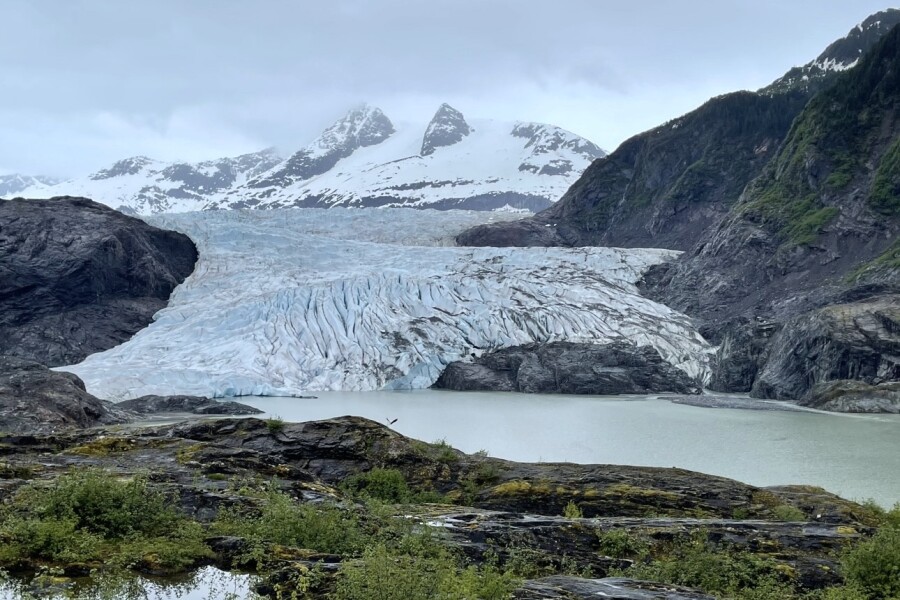Like national parks, U.S. national forests protect a vast array of flora and fauna and preserve some of the most beautiful landscapes in the country. But what sets these spaces apart is that they can be used for other purposes too, like hunting, lumber, and wider recreation. Bonus: Dogs are usually banned on national park trails but welcomed in national forests.
The United States’ 155 national forests encompass more than 188 million acres of public land across the country—or roughly the size of Texas and West Virginia combined. Many national forests border national parks, so they offer similar scenery but are far less trafficked. In fact, it will often feel like you have the protected areas all to yourself.
Here are the eight most beautiful national forests to visit in the United States.
1. Tongass National Forest
Alaska
- Where to stay: Pybus Point Lodge
At 16.9 million acres, Tongass National Forest is the largest of the U.S. national forests. It stretches throughout the Inside Passage region in southeast Alaska (a common destination for cruises to Alaska) alongside British Columbia; it is so vast that it encompasses both the largest temperate rain forest in the world and the nearly 14-mile-long Mendenhall Glacier. Beyond hiking, fishing, and kayaking, bear viewing is also a popular reason to visit Tongass, especially in July when salmon are heading upstream.

Visit San Juan National Forest for Rocky Mountain landscapes.
Photo by My Good Images/Shutterstock
2. San Juan National Forest
Colorado
- Where to stay: Madeline Hotel & Residences Auberge Resorts Collection
San Juan National Forest’s 1.8 million acres have mesas, mountain peaks, as well as ample mountain and gravel biking trails for cyclists and opportunities for off-roading. There’s also a vast network of hiking paths in this part of southwest Colorado, including the perennially popular—and family-friendly—Treasure Falls Trail and the more challenging Island Lake Trail. Parts of the forest are accessible from small towns, including Pagosa Springs, Silverton, and Telluride.

Trees in Olympic National Forest include Sitka spruce, Douglas fir, and western hemlock.
Photo by sc_images/Shutterstock
3. Olympic National Forest
Washington
- Where to stay: Lake Crescent Lodge
On Washington’s Olympic Peninsula, this forest surrounds the national park of the same name. Its nearly 630,000 acres are a study in contrasts—you’ll find both alpine peaks and temperate rain forests here. Check out some of the forest’s nature and interpretive trails, or visit landmarks like Lake Quinault with a four-mile hike along the Quinault Loop. Don’t forget a rain jacket: This area sees an average of more than 150 inches of precipitation each year.

Coconino National Forest covers 1.8 million acres in northern Arizona.
Courtesy of cathughes6/Unsplash
4. Coconino National Forest
Arizona
- Where to stay: Ambiente: A Landscape Hotel
Boasting canyons and Seussically-shaped rock formations typical of the Southwest, Coconino National Forest is a red-hued playground for those keen on hiking, rock climbing, and biking. Stick around after dark and head to the Giovale Open Deck Observatory in Flagstaff (a community surrounded by the national forest) for stellar stargazing.

Shoshone National Forest offers more than 1,000 miles of trails.
Photo by kenkistler/Shutterstock
5. Shoshone National Forest
Wyoming
- Where to stay: Four Seasons Resort and Residences Jackson Hole
Shoshone National Forest, the oldest national forest in the United States, spans a whopping 2.4 million acres. The forest started as part of the Yellowstone Timberland Reserve (most of which is now Yellowstone National Park) and offers wildflower meadows, glassy lakes, and three mountain ranges, plus the 13,804-foot-tall Gannett Peak. Various communities act as gateways to this massive national forest, including Jackson Hole and Cody.

White Mountain National Forest includes nearly 800,000 acres of land.
Courtesy of Cloris Ying/Unsplash
6. White Mountain National Forest
New Hampshire and Maine
- Where to stay: Omni Mount Washington Resort
White Mountain’s 1,200 miles of trails—including a 160-mile segment of the Appalachian Trail—are arguably the most beautiful in the autumn, when foliage in its hardwood and conifer forests change colors. But with a slew of cascading waterfalls and views (check out the Mount Willard Trail and the Welch-Dickey Loop Trail), it’s a national forest worth visiting for more than its leaves.

Minnesota’s Superior National Forest is the largest national forest east of the Mississippi River.
Photo by Michael Siluk/Shutterstock
7. Superior National Forest
Minnesota
- Where to stay: The Oliver Inn
This 3 million–acre park in northern Minnesota is a love letter to the Northwoods, a boreal forest covering parts of Minnesota, Wisconsin, Michigan, New York, Vermont, New Hampshire, and Maine. Stay for the thousands of miles of hiking and backpacking trails that weave through dense forests filled with sugar maples, yellow birch, and red oaks, and lead to memorable vistas (like those on the Bean and Bear Lake Loop). Be sure to keep an eye out for moose, wolves, and bald eagles.

Sierra National Forest is still a great place to visit during the winter.
Courtesy of Cameron Vaughan/Unsplash
8. Sierra National Forest
California
- Where to stay: Autocamp Yosemite
Found in the heart of California’s Sierra Nevada range, this 1.3 million–acre national forest is a captivating tapestry of alpine ecosystems that includes dense forests filled with aspens and mountain hemlocks and the Kings River (a designated Wild and Scenic River) within its boundaries.
Bikers and backpackers can explore an extensive network of trails—which includes part of the Pacific Crest Trail—for mountain meadows and panoramic viewpoints. If you can’t get enough of the area’s natural beauty, head over to the bordering Yosemite or Sequoia and Kings national parks.











